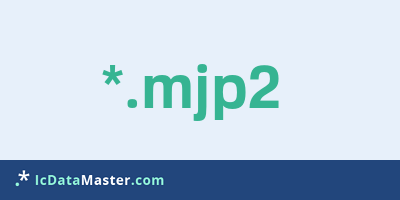Open MJP2 files
-
Full nameJPEG 2000 Motion Sequence Format (ISO 15444-3)
-
DeveloperN/A
What is MJP2 file?

The file extension MJP2 marks an image sequence in the extended JPEG 2000 format. There are several enhancements of the JPEG 200 standard, which open up additional possibilities. The support for the extensions is not yet widespread and does not have to be complete for a program.
More info
The MJP2 file contains a video that is a sequence of JPEG 2000 compressed frames. The file may also contain audio data.
JPEG 2000 is a digital image compression technique that provides both lossless and lossy compression. It has some advantages over JPEG. Image quality is better at high compression rates and some limitations no longer exist. Eg image size, color depths or support for alpha channels (for transparency). However, this is offset by the licensing-related situation and a significantly higher demand for computing power.
The ending MJP2 is more common under Apple Mac OSX. On Windows, the mj2 extension is more commonly used for these types of files.
Some programs can read these files with the help of a plugin.
Programs which can open a MJP2 file
 Windows
Windows
The MJP2 file contains a video that is a sequence of JPEG 2000 compressed frames. The file may also contain audio data.
JPEG 2000 is a digital image compression technique that provides both lossless and lossy compression. It has some advantages over JPEG. Image quality is better at high compression rates and some limitations no longer exist. Eg image size, color depths or support for alpha channels (for transparency). However, this is offset by the licensing-related situation and a significantly higher demand for computing power.
The ending MJP2 is more common under Apple Mac OSX. On Windows, the mj2 extension is more commonly used for these types of files.
Some programs can read these files with the help of a plugin.
Programs which can open a MJP2 file
 Windows
Windows
How to open file with MJP2 extension?
Install Adobe Premiere Pro or other program from the list
Most often resolving problems with opening MJP2 files is very simple. Just install an appropriate program that supports such files. All of the listed programs support MJP2 files, but may vary in offered function and purpose. Some programs may be capable only of viewing contents of MJP2 files or offer file conversion options, but may not be capable of editing such files.
Set Adobe Premiere Pro as the default program for opening MJP2 files
It is possible that although a compatible program has been installed on user’s system, it is not used by the system to open it. This may happen because no default application was associated with this type of files. To associate MJP2 files with given application, select "Open with" from drop-down menu (accessed by right-clicking on the file). Then select from the list the program or application you want to be used to open this type of file. If the Adobe Premiere Pro applications is not on the list, select "Browse" option in order to manually locate the directory where Adobe Premiere Pro has been installed.
Check the section that lists most common problems with MJP2 files
Sometimes problems with opening MJP2 files may not lie with the application itself, but can arise due to other causes, such as:
- File data is corrupted
- MJP2 files has been not been completely download from the internet (only a part of the data has been downloaded)
- Currently used user account hasn’t been granted necessary privileges to open MJP2 files (should that be the case, please contact your system administrator or IT specialist)
- MJP2 file was being copied from a corrupted storage device and is incomplete or data is corrupted. (Copying files from unknown or untrusted sources should be conducted with great care as such files may contain malicious software, which can damage your system)


